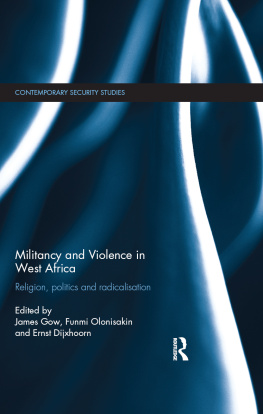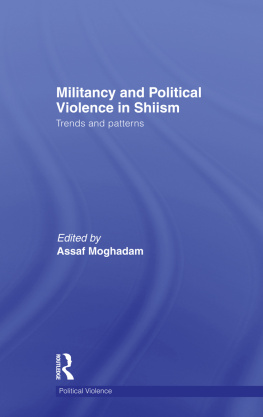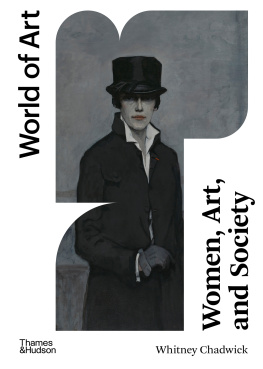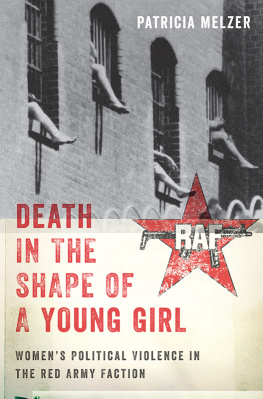after the red army faction
charity scribner
after the red army faction
gender, culture, and militancy
COLUMBIA UNIVERSITY PRESS NEW YORK
COLUMBIA UNIVERSITY PRESS
Publishers Since 1893
NEW YORK CHICHESTER, WEST SUSSEX
cup.columbia.edu
Copyright 2015 Columbia University Press
All rights reserved
E-ISBN 978-0-231-53829-9
Library of Congress Cataloging-in-Publication Data
Scribner, Charity.
After the Red Army faction : gender, culture, and militancy / Charity Scribner.
pages cm
Includes bibliographical references and index.
ISBN 978-0-231-16864-9 (cloth : alk. paper) ISBN 978-0-231-53829-9 (e-book)
1. Rote Armee FraktionIn literatureHistoryExhibitions. 2. Women terrorists in literatureGermany (West)HistoryExhibitions. 3. Terrorism in literatureGermany (West)HistoryExhibitions. 4. Rote Armee FraktionIn mass mediaHistoryExhibitions. 5. Women terrorists in mass mediaGermany (West)HistoryExhibitions. 6. Terrorism in mass mediaGermany (West)HistoryExhibitions. 7. Rote Armee FraktionHistoryExhibitions. 8. Women terroristsGermany (West)HistoryExhibitions. 9. TerrorismGermany (West)HistoryExhibitions. 10. Right and left (Political science)Germany (West)HistoryExhibitions. I. Title.
HV6433.G32R673 2015
363.3250943dc23
2014012080
A Columbia University Press E-book.
CUP would be pleased to hear about your reading experience with this e-book at .
COVER IMAGE: GERHARD RICHTER, ATLAS TAFEL 432, 1989
COVER DESIGN: CHANG JAE LEE
References to websites (URLs) were accurate at the time of writing. Neither the author nor Columbia University Press is responsible for URLs that may have expired or changed since the manuscript was prepared.
To Dorothy Foster Teer
and Dorothy Scribner Foster,
my mother and my grandmother
contents
When I was twelve I traveled from the United States to Germany for the first time. I spent the summer in Hamburg, where I lived with the wonderful Ruhnau family and trained with a gymnastics team. While preparing for the trip, I overheard my grandfather talk about the angry youths who lived in European cities, and how they would shoot businessmen, like him, in the knees. He probably meant the German Red Army Faction or the Italian Red Brigades.
I didnt recall this remark until years later, in 1987, when I was studying abroad at Heidelberg University. I was well aware of anti-American sentiment among certain sectors of the student body. Some of the biggest U.S. army installations at the time were close by in Mannheim, and the streets were often occupied by people protesting the arms race. One night I saw an early performance of Johann Kresniks Tanztheaterstck Ulrike Meinhof. More than the choreography and staging, what made the biggest impression on me was the scene that unfolded After the curtains closed. As the audience spilled out from the theater and onto the open square, we encountered groups of activists handing out pamphlets and selling books about the RAFmany with illustrations. The pictures that stayed with me the longest were those of Ulrike Meinhof.
Who was this woman, and what do her pictures mean to those of us who study German culture and history? I returned to this question in graduate school at Columbia, where I had the occasion to cross over from comparative literature and write my first paper in art historyon Gerhard Richters October 18, 1977 paintings and Hans Magnus Enzensbergers book Mausoleum. My dissertation and first years of teaching took me in other directions, but two things brought me back to the topics of militancy, terrorism, and their representation. One was the attack on the World Trade Center, which I experienced from the safe distance of 125th Street in Manhattan, while on a brief trip away from my postdoc apartment in Berlin. The other was feminism, my thoughts about feminism and resistance. My first book, which I had set out to write about gender and socialism, evolved into a project about collective memory. I wanted to write another book in the field of cultural studies that would put women in the middle of the picture.
At the Massachusetts Institute of Technology I taught Plotting Terror in European Culture, and in working with my students I came see to how prominently women figured in the art, literature, and film that responded to the RAFs rise and fall. That course became a foundation for this book. After the Red Army Faction has been nearly ten years in the making. Besides the students who took Plotting Terror for the first two semesters I taught it, I have many individuals and institutions to thank for enlivening my research. Id like to mention them here.
A number of sponsors have funded my work. I received much-needed grants from the Professional Staff Congress of the City University of New York, the Alexander von Humboldt Stiftung, and the Class of 1954 Career Development Professorship at MIT. My research was advanced through participation in several CUNY programs: the Center for the Humanities, the Faculty Fellows Publication Program, the Faculty Scholars Publication Workshop, and especially the Center for Place, Culture, and Politics, where Ruthie Gilmore, David Harvey, and Peter Hitchcock gave me a chance to discuss this project with other like-minded scholars. Earlier on I benefited from access to the archival resources at the Hamburg Institute for Social Research, and I wrote early chapter drafts on these documents while working as a visiting professor at Balliol College, Oxford, in 2006.
I appreciate the cooperation of several artists and writers: Thilo Beu, Johan Grimonprez, Alexander Kluge, Gerhard Richter, and Margarethe von Trotta. Yvonne Rainer kindly extended to me the rights to use video stills from her film Journeys from Berlin/1971 and to quote at length from the screenplay. For aid in coordinating permissions to cite and reproduce the works that enrich my book, I acknowledge the archive of the Hamburg Institute for Social Research, the Goethe Institute-New York, the Alliance Franaise-New York, the Marian Goodman Gallery, and the Rainer Werner Fassbinder Foundation.
My colleagues and students continue to be the greatest inspiration. Thanks to the Department of Writing and Literature at LaGuardia Community College, the Department of Comparative Literature at the CUNY Graduate Center, and to the Program in Foreign Languages and Literatures at MIT. From these different homes and from my travels Ive had the good fortune to meet the many people who have read and commented on different parts of the manuscript that became this book. They are Nora Alter, Karen Bauer, Benjamin Buchloh, Sarah Colvin, Isabelle de Courtivron, Ed Dimendberg, Thomas Elsaesser, Tina Gerhardt, Paul Greenberg, Karrin Hanshew, Ursula Heise, Andreas Huyssen, Eric Kligerman, Hans Kundnani, Esther Leslie, Laura Liu, Samantha Majic, Tom McDonough, Leith Passmore, Julian Preece, Ute Staiger, Henriette Steiner, Despina Stratigakos, Margaret Sundell, Edward Baron Turk, Sabine von Dirke, Andrew Webber, John Zilcosky, and Slavoj iek. Thinking through their commentsalong with the invaluable reports a received from anonymous reviewers at the Columbia University PressI was able to deepen my grasp of the books material and sharpen my arguments.
Others have enabled the production of this project in different ways, both in its conception and with a range of practical matters. Im grateful for the assistance of Jrn Ahrens, Eduardo Cadava, Sorin Cucu, Steve dArcy, Brent Edwards, Geoff Eley, Konstanze Ell, Felix Ensslin, Bettina Funcke, Anke Geertsma, Cigdem Gymen, Dagmar Herzog, Richard Huff-man, John Hutnyk, Farideh Koohi-Kamali, Phillip Khoury, Carrie Lambert, Anahit Martirosjan, Christine Marx, Helke Sander, Alex Star, Katie Trumpener, Jamie Trnka, Greg Wilpert, Hannah Winarsky, and Rebecca Wittmann. Here Markus Mller stands out for giving me access to research files at the Kunst-Werke Institute for Contemporary Art in Berlin and responding to an ongoing series of emails. I am also indebted to an inner circle of family, friends, and associates who have supported me over the years that I worked on this book. They are my parents, Simone Burgos, Angelica Emmanuel, Hillary Grill, Angela Le, LaRose Parris, Harlan Protass, Steve Silber, and the staff of Clayman and Rosenberg. Special mention goes to my son, Simon, for his excellent company in the last months of revising the manuscript and for teaching me how to do new things with my computer keyboard.








